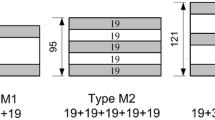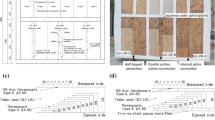Abstract
Light Timer Frame Walls are made of solid timber elements and are usually fire protected by other materials. This investigation determines the residual load bearing capacity of Light Timber Frame Walls for fire rating periods of 30, 60, 90 and 120 min. The timber frame is made with 3 studs and 2 tracks, using two different fire protection levels (one and two gypsum layers). The computational model includes the thermal analysis under standard fire, including all types of materials and a sequential mechanical analysis with incremental load applied for each fire rating periods, applied just for the load bearing material. Nonlinear solution methods are used with small tolerance values for solution convergence, to determine the correct temperature and displacement fields. The thermal and the mechanical properties are considered temperature dependent. The mechanical analysis considers large displacement behaviour, and the charring effect of wood is included by the reduction of the stiffness and strength of the timber. The results show that the load bearing capacity decreases with the fire exposure time. A new proposal is presented between the load bearing capacity and the fire rating and finally the char layer is compared with the current and future version of Eurocode 5, part 1.2.












Similar content being viewed by others
References
CEN, “EN 1363-1: Fire resistance tests Part 1: General Requirements.” CEN- European Committee for Standardization, Brussels, p. 52 (2020)
CEN, EN 1365-1: Fire resistance tests for loadbearing elements-Part 1: Walls, CEN. Brussels: CEN (2013)
ISO, ISO834-1: Fire-resistance tests - Elements of building construction-Part 1: General requirements. International Organization for Standardization (1999)
CEN, EN 1364-1: Fire resistance tests for non-loadbearing elements. Part 1: Walls, CEN. Brussels: CEN (2015)
CEN, EN 13501-2: Fire classification of construction products and building elements-Part 2: Classification using data from fire resistance tests, excluding ventilation services, CEN. Brussels: CEN (2016)
Takeda, H., Mehaffey, J.R.: WALL2D: A model for predicting heat transfer through wood-stud walls exposed to fire. Fire Mater. 22(4), 133–140 (1998). https://doi.org/10.1002/(SICI)1099-1018(1998070)22:4%3c133::AID-FAM642%3e3.0.CO;2-L
Piloto, P.A.G., Fonseca, E.M.M.: Timber framed walls lined with gypsum plates under fire. In: 7th International Conference Integrity-Reliability-Failure, pp. 547–556 (2020)
Gernay, T.: Modelling thermal performance of gypsum plasterboard-lined light timber frame walls using SAFIR and TASEF. Fire Mater. 34(8), 385–406 (2010). https://doi.org/10.1002/fam.1026
Franssen, J.-M.: SAFIR. A thermal/ tructural program modelling structures under fire. Eng. J. Am. Inst. Steel Constr. 42(3), 143–158 (2005). https://www.aisc.org/SAFIR-A-Thermal-and-Structural-Program-for-Modeling-Structures-Under-Fire
Sterner, E., Wickstrom, U.: TASEF—temperature analysis of structures exposed to fire-Users manual. Boras (1990). https://www.diva-portal.org/smash/get/diva2:961683/FULLTEXT01.pdf
Thi, V.D., Khelifa, M., Oudjene, M., El Ganaoui, M., Rogaume, Y.: Numerical simulation of fire integrity resistance of full-scale gypsum-faced cross-laminated timber wall. Int. J. Therm. Sci. 132(June), 96–103 (2018). https://doi.org/10.1016/j.ijthermalsci.2018.06.003
Bedon, C., Fragiacomo, M.: Experimental and numerical analysis of in-plane compressed unprotected log-haus timber walls in fire conditions. Fire Saf. J. 107(December 2017), 89–103 (2019). https://doi.org/10.1016/j.firesaf.2017.12.007
Fonseca, E.M.M., Leite, P.A.S., Silva, L.: Wood connections under fire conditions protected with gypsum plasterboard types A and F. In: Advances in Fire Safety Engineering, pp. 93–106 (2020)
Qin, R., Zhou, A., Chow, C.L., Lau, D.: Structural performance and charring of loaded wood under fire. Eng. Struct. 228(2020), 111491 (2021). https://doi.org/10.1016/j.engstruct.2020.111491
Piloto, P., Khetata, M., Gavilán, A.: Fire resistance tests of non-loadbearing LSF walls. In: TEST &E 2019—2nd Conference on Testing and Experimentations in Civil Engineering—Proceedings, pp. 429–440 (2019). https://doi.org/10.5281/zenodo.3355354
Khetata, S.M., Piloto, P.A.G., Gavilán, A.B.R.: Fire resistance of composite non-load bearing light steel framing walls. J. Fire Sci. 38(2), 136–155 (2020). https://doi.org/10.1177/0734904119900931
CEN, “EN 1995-1.2, Eurocode 5: Design of timber structures-Part 1–2: General-Structural fire design. CEN-European Committee for Standardization, Brussels, pp. 1–69 (2004)
CEN, “pr EN 1995-1.2, Eurocode 5: Design of timber structures—Part 1–2: General-Structural fire design.” CEN-European Committee for Standardization, Brussels (2020)
Sultan, M.A.: A model for predicting heat transfer through noninsulated unloaded steel-stud gypsum board wall assemblies exposed to fire. Fire Technol. 32(3), 239–259 (1996). https://doi.org/10.1007/BF01040217
Holmberg, S., Persson, K., Petersson, H.: Nonlinear mechanical behaviour and analysis of wood and fibre materials. Comput. Struct. 72(4), 459–480 (1999). https://doi.org/10.1016/S0045-7949(98)00331-9
Milhan, T.H.: Numerical study on wooden beams subjected to high temperatures (in Portuguese). Instituto Politécnico de Bragança, MSc thesis (2020)
Guan, Z.W., Zhu, E.C.: Finite element modelling of anisotropic elasto-plastic timber composite beams with openings. Eng. Struct. 31(2), 394–403 (2009). https://doi.org/10.1016/j.engstruct.2008.09.007
Rodney, H., Soc, R.: A theory of the yielding and plastic flow of anisotropic metals. Proc. R. Soc. Lond. Ser. A. Math. Phys. Sci. 193(1033), 281–297 (1948). https://doi.org/10.1098/rspa.1948.0045
Schleifer, V.: Zum Verhalten von raumabschliessenden mehrschichtigen Holzbauteilen im Brandfall, ETH Library (2009)
Frangi, A., Schleifer, V., Fontana, M.: Design model for the verification of the separating function of light timber frame assemblies. Eng. Struct. 32(4), 1184–1195 (2010). https://doi.org/10.1016/j.engstruct.2009.12.044
Nele Mäger, K., Just, A., Frangi, A., Brandon, D.: International network on timber engineering research. In: International Network on Timber Engineering Research, pp. 439–451 (2017)
Nele, M.K., Alar, J., Frangi, A.: Improvements to the component additive method. In: 10th International Conference on Structures in Fire, pp. 283–290 (2018)
CEN, “EN 1991-1-2, Eurocode 1: Actions on structures—Part 1–2: General actions—Actions on structures exposed to fire,” CEN- European Committee for Standardization. CEN- European Committee for Standardization, Brussels, p. 59 (2002)
Dai, B., Zheng, B., Liang, Q., Wang, L.: Numerical solution of transient heat conduction problems using improved meshless local Petrov–Galerkin method. Appl. Math. Comput. 219(19), 10044–10052 (2013). https://doi.org/10.1016/j.amc.2013.04.024
Author information
Authors and Affiliations
Corresponding author
Additional information
Publisher's Note
Springer Nature remains neutral with regard to jurisdictional claims in published maps and institutional affiliations.
Rights and permissions
Springer Nature or its licensor (e.g. a society or other partner) holds exclusive rights to this article under a publishing agreement with the author(s) or other rightsholder(s); author self-archiving of the accepted manuscript version of this article is solely governed by the terms of such publishing agreement and applicable law.
About this article
Cite this article
Piloto, P.A.G., Fonseca, E.M.M. Load Bearing Capacity of Light Timber Frame Walls Under Fire. Math.Comput.Sci. 16, 8 (2022). https://doi.org/10.1007/s11786-022-00521-y
Received:
Revised:
Accepted:
Published:
DOI: https://doi.org/10.1007/s11786-022-00521-y




